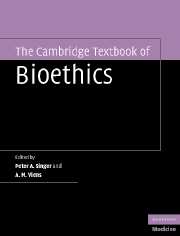Book contents
- Frontmatter
- Contents
- List of contributors
- Acknowledgements
- 1 Introduction
- Section I Information problems
- Section II End of life care
- Section III Pregnant women and children
- Introduction
- 14 Ethical dilemmas in the care of pregnant women: rethinking “maternal–fetal conflicts”
- 15 Prenatal testing and newborn screening
- 16 Assisted reproduction
- 17 Respectful involvement of children in medical decision making
- 18 Non-therapeutic pediatric interventions
- 19 Child abuse and neglect
- Section IV Genetics and biotechnology
- Section V Research ethics
- Section VI Health systems and institutions
- Section VII Using clinical ethics to make an impact in healthcare
- Section VIII Global health ethics
- Section IX Religious and cultural perspectives in bioethics
- Section X Specialty bioethics
- Index
- References
16 - Assisted reproduction
Published online by Cambridge University Press: 30 October 2009
- Frontmatter
- Contents
- List of contributors
- Acknowledgements
- 1 Introduction
- Section I Information problems
- Section II End of life care
- Section III Pregnant women and children
- Introduction
- 14 Ethical dilemmas in the care of pregnant women: rethinking “maternal–fetal conflicts”
- 15 Prenatal testing and newborn screening
- 16 Assisted reproduction
- 17 Respectful involvement of children in medical decision making
- 18 Non-therapeutic pediatric interventions
- 19 Child abuse and neglect
- Section IV Genetics and biotechnology
- Section V Research ethics
- Section VI Health systems and institutions
- Section VII Using clinical ethics to make an impact in healthcare
- Section VIII Global health ethics
- Section IX Religious and cultural perspectives in bioethics
- Section X Specialty bioethics
- Index
- References
Summary
Ms. F and Mr. G are trying to have a child. They have been having sexual intercourse approximately three times a week for the past year, and daily around the time when Ms. F thinks she is ovulating. They are both 38 years old. Ms. F has had regular menstrual cycles up to the last three months, in which she has had only two. They are worried they have delayed starting a family too long and will not be able to afford the expensive fertility treatment they may require at Ms. F's age. They have questions regarding the success of in vitro fertilization and the possibility of having twins or triplets.
What is assisted reproduction?
Assisted reproduction enables the deliberate manipulation of the processes and materials of human reproduction outside of sexual intercourse. In describing the practices that constitute assisted reproduction, it must be understood that all such practices are embedded with ethical issues, whether standard therapies such as ovulation induction (Messinis, 2005), insemination with donor sperm (Daniels et al., 2006), and in vitro fertilization (IVF) (Steptoe and Edwards, 1978); emerging practices such as pre-implantation genetic diagnosis (PGD) (Handyside, 1990; Nisker and Gore-Langton, 1995); or practices prohibited under law in many countries, such as the purchase or bartering of oocytes (Gurmankin, 2001; Nisker, 1996, 1997, 2001).
Ovulation induction through clomiphene citrate has been practiced for over 30 years (Messinis, 2005).
- Type
- Chapter
- Information
- The Cambridge Textbook of Bioethics , pp. 112 - 120Publisher: Cambridge University PressPrint publication year: 2008



